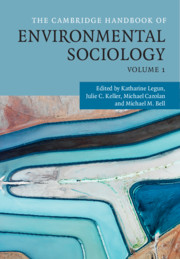Book contents
- The Cambridge Handbook of Environmental Sociology Volume 1
- The Cambridge Handbook of Environmental Sociology
- Copyright page
- Contents
- Figures
- Tables
- Contributors
- Foreword
- Introduction
- Part I Theory in Environmental Sociology
- 1 Classical Theory and Environmental Sociology: Toward Deeper and Stronger Roots
- 2 Globalizing Environmental Sociology
- 3 An Embodied Materialist Sociology
- 4 The Environmental Sociology of the Good: Nature, Faith, and the Bourgeois Transition
- 5 Microsociological Perspectives in Environmental Sociology
- Part II The Economy and Environmental Sociology
- Part III Culture and Environmental Sociology
- Part IV Politics, Power, State
- Part V Social Justice
- Index
- References
5 - Microsociological Perspectives in Environmental Sociology
from Part I - Theory in Environmental Sociology
Published online by Cambridge University Press: 05 November 2020
- The Cambridge Handbook of Environmental Sociology Volume 1
- The Cambridge Handbook of Environmental Sociology
- Copyright page
- Contents
- Figures
- Tables
- Contributors
- Foreword
- Introduction
- Part I Theory in Environmental Sociology
- 1 Classical Theory and Environmental Sociology: Toward Deeper and Stronger Roots
- 2 Globalizing Environmental Sociology
- 3 An Embodied Materialist Sociology
- 4 The Environmental Sociology of the Good: Nature, Faith, and the Bourgeois Transition
- 5 Microsociological Perspectives in Environmental Sociology
- Part II The Economy and Environmental Sociology
- Part III Culture and Environmental Sociology
- Part IV Politics, Power, State
- Part V Social Justice
- Index
- References
Summary
We begin with a brief historical overview of how leading environmental sociologists from the 1970s and 1980s largely criticized or rejected microsociological theorists for contributing to the wider problem of human exemptionalism. We then document how, since the 1990s, the microsociological theories of George Herbert Mead and Erving Goffman were creatively brought to bear on environmental concerns, contrary to earlier accusations that they were irrelevant to the field. In the second half of the chapter, we consider other, more recent micro-theoretical developments in environmental sociology involving pragmatist action theory, actor-network theory, and human-nonhuman animal interaction. We argue that such developments constitute a gravitational shift in environmental microsociological theorizing in the importance they place on the social situation for environmental action, departing from the earlier focus on self and identity. In line with this, we propose small group dynamics be included in the focus on social situations.
Keywords
- Type
- Chapter
- Information
- The Cambridge Handbook of Environmental Sociology , pp. 74 - 92Publisher: Cambridge University PressPrint publication year: 2020
References
- 1
- Cited by

